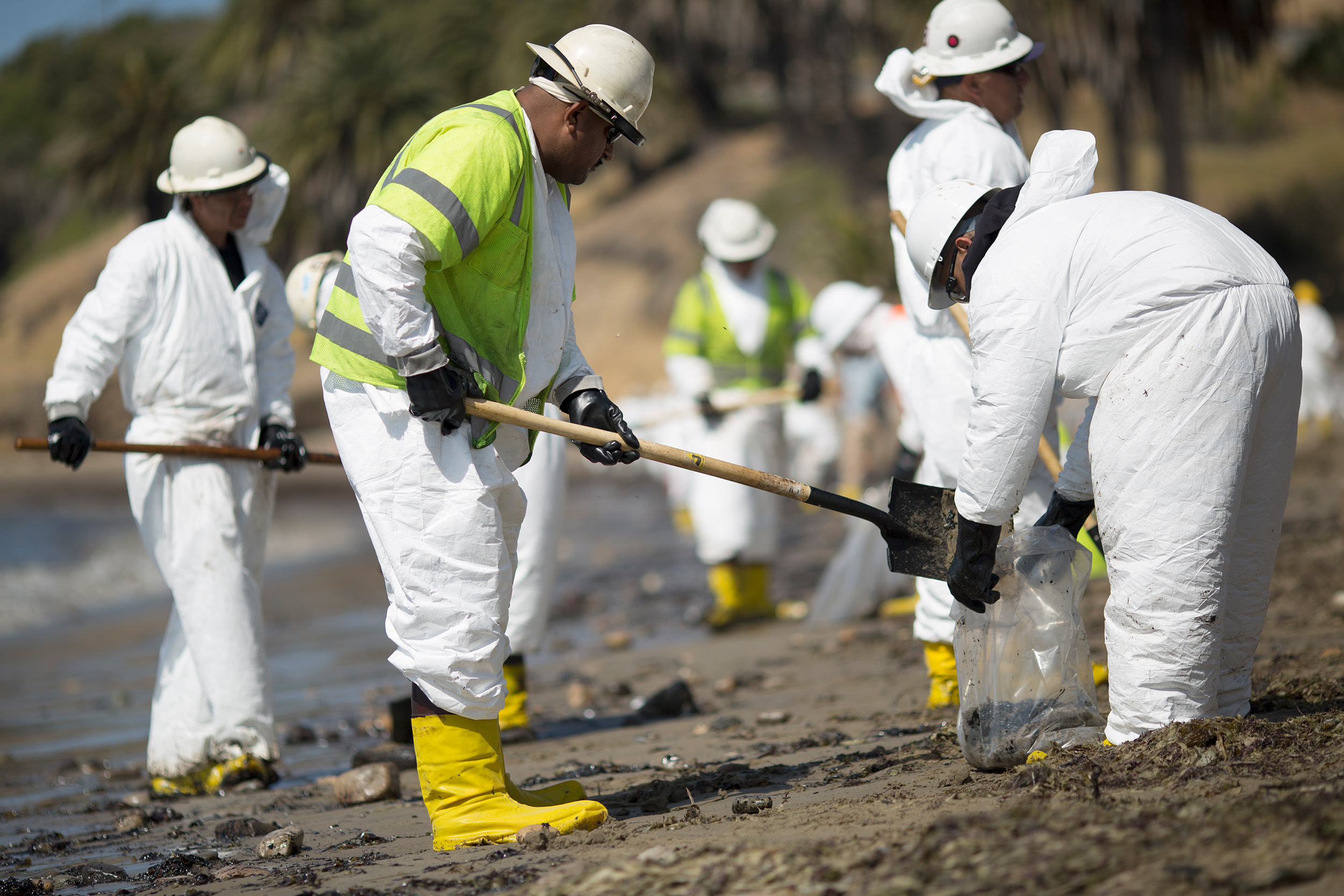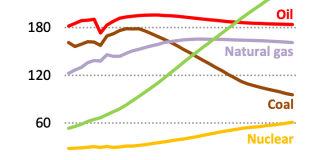President Donald Trump may announce his plan to open California waters to oil drilling as soon as this week. The move, if it goes through, could bring about the first federal oil lease sales in the Pacific Ocean since 1984.
But for one company trying to restart production at a set of wells under an existing lease off the Santa Barbara coast, the troubles are snowballing.
The Santa Barbara County Board of Supervisors voted last week to prepare to deny the transfer of onshore infrastructure permits to Sable Offshore Corp., which in 2024 purchased ExxonMobil’s Santa Ynez Unit, a dormant system of pipelines and three oil rigs, with the intention to resume drilling.
The Tuesday vote was a re-do of a 2-2 split vote by the supervisors in February. The decision had been kicked up to the board after environmental groups appealed the county planning commission’s October 2024 vote to approve the permit transfers. Sable sued the county in May after the tie vote, alleging that the county was illegally withholding permits; in September, a judge ordered the county to vote again.
Since February, a slew of lawsuits, as well as a leaked call suggesting Sable’s CEO shared insider information with a select group of investors, tipped one normally pro-drilling supervisor against the company.
“The landscape has changed dramatically,” said Supervisor Steve Lavagnino, citing a litany of charges and fines levied against Sable in recent months. “Without spilling a single drop of oil, Sable has managed to push back the reputation of the industry 20 years.”
The Santa Ynez Unit was the source of one of the worst oil spills in California history in 2015, when a corroded pipe ruptured and spilled more than 450,000 gallons of oil near Refugio State Beach in Santa Barbara. The system had lain dormant since then, but last year Sable, a company formed with a loan from Exxon to purchase the unit, began work on its pipelines.
In October, the company lost a critical courtroom battle with the California Coastal Commission, which had fined Sable $18 million, the largest fine in the agency’s history, for starting pipeline repair work without coastal development permits and then violating cease-and-desist orders. The company argued it was already covered by existing permits, but Santa Barbara Superior Court Judge Thomas Pearce Anderle upheld the Commission’s orders, a decision Sable said it would appeal.
The Santa Barbara district attorney brought 21 criminal charges against the company in September for the environmental damages it allegedly wrought by starting the repair work.
State Attorney General Rob Bonta then brought civil charges in October, when he sued on behalf of the Central Coast water board for what it claimed were unauthorized waste discharges into local waterways.
The company’s shareholders are also suing, alleging that Sable’s executives harmed the company by prematurely claiming it would restart operations. The State Lands Commission rebuked the company in May for announcing that it had restarted production on the anniversary of the Refugio Beach oil spill when, the commission said, it was only doing well testing and didn’t have approvals for commercial production yet.

And while the California State Fire Marshal did issue a waiver in December 2024 to allow Sable to restart its pipeline system, two environmental groups sued the state over that decision, alleging that Sable’s plans do not include fixing the corrosion issues that led to the 2015 spill.
After Sable announced in late September that it had submitted its formal request to Fire Marshal Daniel Berlant to restart production, Berlant sent Sable a letter saying that it was out of compliance with its waiver and its restart plan would not be approved until its pipeline repairs were complete. (Sable disputed his conclusion.)
“They can’t do any more work on the pipeline right now because they don’t have a coastal development permit from the Coastal Commission,” said Julie Teel Simmonds, a senior attorney for the oceans program at the Center for Biological Diversity, one of the groups suing over the fire marshal waiver. “They’re in a bind for a lot of reasons.”
That’s why, in late September, Sable also announced that it was pursuing “an offshore storage and treating vessel strategy” to drill oil in federal waters, where its platforms are located, and bring the oil to markets outside California with tankers to circumvent state pipeline regulations. On Sept. 19, the company wrote to Interior Secretary Doug Burgum and Energy Secretary Chris Wright requesting expedited permitting.
In the leaked investor call that was the subject of an Oct. 31 investigation by the outlet Hunterbrook, Sable CEO James Flores cited ties to Wright and Commerce Secretary Howard Lutnick, as well as plans to leverage Trump’s support for domestic oil production, to secure federal funding.
The U.S. departments of Energy and the Interior, which celebrated Sable as a “win for American Energy Dominance” in July after it announced the restart of production, did not respond to requests for comment.
Sable declined to comment on its plans to procure a shipping vessel and secure support from the Trump administration. The company told investors it was investigating the Hunterbrook report that revealed its CEO may have shared nonpublic information with a select group, including pro golfer Phil Mickelson.
In a statement to Inside Climate News after last week’s Santa Barbara County Board of Supervisors vote, Sable Vice President Harrison Breaud said the company “has met all requirements for the permit transfer as confirmed by Santa Barbara County staff” and that the decision “does not impact Sable’s plans to re-commence oil sales.”
But going the shipping route, even if it gets a boost from Trump, may present Sable new challenges.
This story is funded by readers like you.
Our nonprofit newsroom provides award-winning climate coverage free of charge and advertising. We rely on donations from readers like you to keep going. Please donate now to support our work.
For one, buying a vessel and transporting oil by ship is more expensive than bringing it to shore through the pipelines. At a time when oil prices are low, investors may be hesitant to bet on the company, said Clark Williams-Derry, an analyst with the Institute for Energy Economics and Financial Analysis.
Sable’s stocks went tumbling last week after the allegations of insider trading and the company’s announcement that it would have to raise $225 million to extend a loan with Exxon.
“They may be able to make it happen, but they’re going to have to raise more money,” said Williams-Derry. “There may be companies who want to take a risk on drilling offshore in California, but right now the price of oil is around $60 a barrel and the industry is cutting back on drilling, rather than looking to expand.”
And Sable could still run into more legal challenges.
“They have a sympathetic administration now, but my guess is that there would be litigation over those permits, if one were issued,” said Deborah Ann Sivas, co-director of Stanford University’s environmental law clinic. “That would potentially slow Sable down or be costly, and my understanding is that they’re kind of precarious financially.”
Drilling off the California coast has been heavily restricted since a 1969 oil spill near Santa Barbara poured 3 million gallons of crude oil into the ocean and helped spark the modern environmental movement. In 1994 the state banned new drilling in waters under its jurisdiction, which extends to the first three miles off the shore, and only two active rigs remain in the zone from before the moratorium.
In federal waters, the Pacific, like the Atlantic, has been subject to various leasing restrictions over the past 40 years. California has 22 rigs operating off its coast under federal jurisdiction, but there hasn’t been a new auction since 1984.
In October, news broke that the Interior Department planned to open federal waters off the Atlantic and California coasts as part of its upcoming five-year plan for lease sales for offshore oil drilling. The Trump administration backed off the Atlantic after facing Republican opposition, but the Washington Post reported Tuesday that it planned to allow rigs in areas long closed to drilling off the California coast and to expand drilling in the eastern Gulf of Mexico.
Environmental groups sued the Trump administration in February over his executive orders to put millions of acres of federal waters that the Biden administration had protected back under consideration for drilling. California Gov. Gavin Newsom and other state leaders wrote letters in opposition to offshore drilling over the summer, noting that the state banned new infrastructure to transport oil and gas from federal waters through state waters in 2018.
Experts question how much interest there will be if lease areas open, given the low price of oil and the fact that waters off the California coast have smaller accessible resources than other areas, like the Gulf of Mexico.
“There are better prospects elsewhere,” said Williams-Derry.
Sable, which the Interior Department said is sitting on 80 percent of the remaining recoverable reserves in the Pacific Outer Continental Shelf, already has its federal leases. But Teel Simmonds, of the Center for Biological Diversity, said an updated development and production plan would still have to comply with a host of federal laws. Many, like the National Environmental Policy Act, the Coastal Zone Management Act and the Outer Continental Shelf Lands Act, require state input or consultation. And local jurisdictions, like the Santa Barbara County Air Pollution Control District, which gives air permits, would still have some authority over operations in federal waters.
“Sable can’t just wave its wand and have offshore oil processing and tankering approved,” said Teel Simmonds. “And the state of California can’t be cut out just by running to the Trump administration.”
About This Story
Perhaps you noticed: This story, like all the news we publish, is free to read. That’s because Inside Climate News is a 501c3 nonprofit organization. We do not charge a subscription fee, lock our news behind a paywall, or clutter our website with ads. We make our news on climate and the environment freely available to you and anyone who wants it.
That’s not all. We also share our news for free with scores of other media organizations around the country. Many of them can’t afford to do environmental journalism of their own. We’ve built bureaus from coast to coast to report local stories, collaborate with local newsrooms and co-publish articles so that this vital work is shared as widely as possible.
Two of us launched ICN in 2007. Six years later we earned a Pulitzer Prize for National Reporting, and now we run the oldest and largest dedicated climate newsroom in the nation. We tell the story in all its complexity. We hold polluters accountable. We expose environmental injustice. We debunk misinformation. We scrutinize solutions and inspire action.
Donations from readers like you fund every aspect of what we do. If you don’t already, will you support our ongoing work, our reporting on the biggest crisis facing our planet, and help us reach even more readers in more places?
Please take a moment to make a tax-deductible donation. Every one of them makes a difference.
Thank you,
Great Job By Blanca Begert & the Team @ Inside Climate News Source link for sharing this story.





